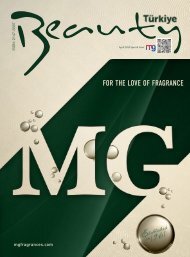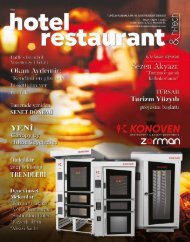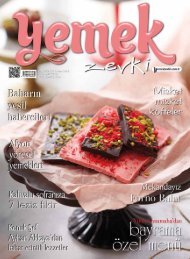Tekstil Teknik October 2020
Tekstil Teknik October 2020
Tekstil Teknik October 2020
- No tags were found...
You also want an ePaper? Increase the reach of your titles
YUMPU automatically turns print PDFs into web optimized ePapers that Google loves.
38 İNCELEME
Sözkonusu t zamanı ile Ct konsantrasyonu
arasındaki ilişki aşağıdaki formülde verilmiştir:
t= C0’dan Ct’ye geçen zaman
C0=Başlangıç Konsantrasyonu
Ct = t zamanında konsantrasyon
C∞ = Beklenen Denge Konsantrasyonu (R/Epu)
V = Tekne hacmi
Epu = Efektif pick-up (Q1*f+∆Q)
m = Dakikada geçen kumaş ağırlığı (kumaş/dk)
Bu makalenin ilerleyen bölümlerinde, belirli
bir kumaş ile çalışırken önemli işlem parametrelerinin
çoğunun nasıl ele alınacağını
açıklayacağız. Bu parametreleri bildikten
sonra, emprenye sisteminin tanımlanmış
bir konsantrasyona ulaşması için gereken
zamanı hesaplayabiliyor olacağız...
Bu noktada, beklenen kimyasal denge konsantrasyonunun
±% 5 veya ±% 10’luk bir hassasiyetle
eşlenecek şekilde emprenye ünitesinin
“tepki süresi”ni hesaplamak artık kolaydır.
The time necessary to reach a new equilibrium
is called the responding time and is based on a
time t=∞.
Waiting or calculating the time t=∞ for reaching
the concentration C∞ is not possible and only
used in the above formulas. Knowing that we
always will have some fluctuations in the concentration
of the impregnating bath we will use a
bandwidth above and below the equilibrium. As
such we can calculate with a more realistic time
for reaching a “safe” concentration in the impregnating
unit.
The responding time can be calculated by the
above formula of the equilibrium
Ct is defining the concentration of the impregnating
liquid depending on the time t.
For every value of Ct we will have a defined value
for t and of course inverse, every time t is related
to a concentration Ct.
The relation between t and Ct is given in following
formula:
TEKSTİL & TEKNİK | EKİM | OCTOBER | 2020
C5 = C∞ * 0,95 Başlangıç konsantrasyonu beklenen
denge konsantrasyonundan düşükse
C5 = C∞ * 1,05 Başlangıç konsantrasyonu
beklenen denge konsantrasyonundan
yüksekse
(C10 için sırasıyla 0,90 ve 1,10)
Şekil 3’teki diyagram , aşağıda verilen örnekteki
değerleri kullanarak , farklı kumaşlarla
bir üretim çalışmasını simüle ederek ,
tepki süreleri hakkında bir fikir vermektedir.
Örnek:
Bir üretim önce A kumaşı ile başliyor, 200
dakika sonra B kumaşına geçiliyor ve 400
dakika sonra da tekrar A kumaşı olarak
devam ediyor.
Her 2 kumaş için 35 ml/kg’lık bir reçete olsun
Proses Hızı : 80 m/dak
Emprenye ünitesinin flote miktarı : 250 lt (Şekil 3)
Kumaş A’nın parametreleri
Gramaj: 275 [g/m] or 0,275 [kg/m]
Q1: 70% veya 0,70 [l/kg]
Q2: 110% veya 1,10 [l/kg]
f: 0,55
Kumaş B’nin parametreleri:
Gramaj : 250 [g/m] or 0,250 [kg/m]
Q1: 65% veya 0,65 [l/kg]
Q2: 100% veya 1,00 [l/kg]
f: 0,45
where
t = time from C0 to Ct
C0 = concentration at the start
Ct = concentration at the time t
C∞ = expected equilibrium (R/Epu)
V = volume of the compartment
Epu = effective pick-up (Q1*f+∆Q)
m = weight of fabric/min
Further in this paper we will explain how to get
hold of most of the important parameters when
processing a certain fabric. Once we know these
parameters, we will be able to calculate the time
which is necessary for the impregnating system to
strive for a defined concentration.
At this point it is easy to calculate the “responding
time” of the unit to match with a safe concentration
± 5 or ± 10 % of the expected equilibrium.
C5 = C∞ * 0,95 if the starting concentration is lower
than the expected equilibrium
C5 = C∞ * 1,05 if the starting concentration is higher
than the expected equilibrium
(for C10 respectively 0,90 and 1,10)

















